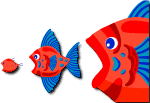 Someone has joked that, for animals, the concept of ecological niche can be defined by what an organism eats, and what eats the organism. In truth, the whole business of who eats whom is interesting to think about.
Someone has joked that, for animals, the concept of ecological niche can be defined by what an organism eats, and what eats the organism. In truth, the whole business of who eats whom is interesting to think about.
NATURAL PREDATORS
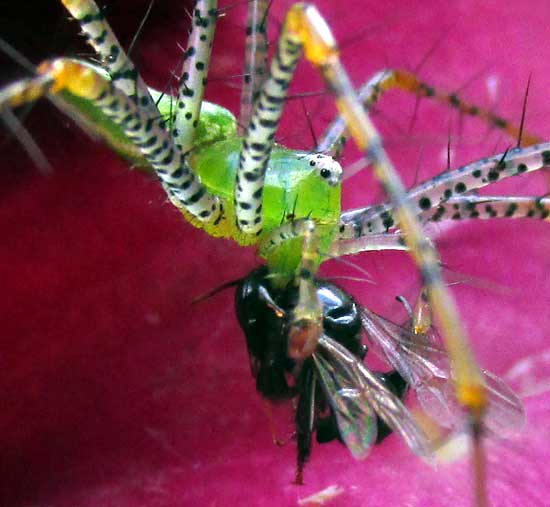
Natural predators abound, even in urban backyards. Songbirds at the feeder always are looking around, knowing that even there there's a chance of being snatched up by a hawk or falcon. Before a bird gets eaten, it itself may have eaten insects up in the trees or down in the grass. Even in soil beneath our lawns there are predators and prey. In one day a tunneling mole may eat up to 60 to 100% of its body weight in insects, grubs, and earthworms. At the right, a Green Lynx spider, Peucetia viridans, has just pounced on an insect inside a flower.
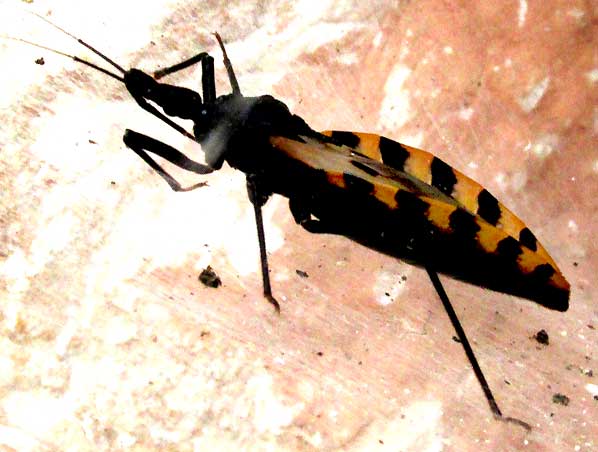
You know how mosquitoes search victims from which nutrient-rich blood can be robbed. Other insects do the same, and they don't necessarily need human blood. The Kissing Bug, Triatoma dimidiata, at the left, which spreads Chagas disease among humans, was seen walking on the ground toward a sleeping dog. When it reached the dog, it lifted up its front end and began to insert its slender, straw-like proboscis into the dog's skin.
THE DOMESTIC CAT PROBLEM
In our backyards natural predators such as bobcats, foxes, weasels, skunks, certain snakes, and even turtles (who snatch ducklings from below the water) are usually absent. However, too often there's one predator who decimates backyard wildlife -- the house cat. Each year, domestic cats kill billions of birds just in the US. If house cats were kept in houses, numbers of squirrels, birds, lizards, frogs and many other wild backyard animals in our towns and cities would blossom dramatically. Wikipedia has a good page linking to scientific studies of the issue, called Cat predation on wildlife.
PARASITES
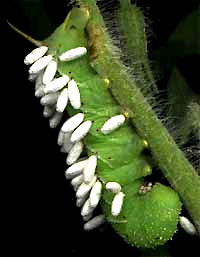
Most wild animals, including those in our neighborhoods, are being eaten alive all the time -- by parasites. One spectacular case of that is seen at the left. This is a caterpillar of the Tobacco Hornworm, Manduca sexta, parasitized by a Braconid wasp. The wasp laid eggs on the caterpillar's skin, and when the larvae hatched they burrowed directly from the eggs into the caterpillar's living body. Supposedly as the larvae ate more and more of the caterpillar's interior, the caterpillar gradually lost its body functions and probably felt worse every day. Eventually the enlarged larvae burrowed to the caterpillar's surface, or skin, and spun the white cocoons you see. The caterpillar in the picture was still alive, but not moving.
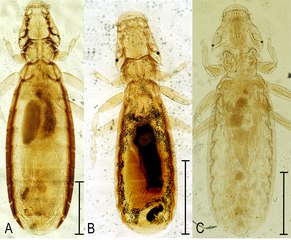 Chewing lice, genus Ricinus, parasitic on birds; image courtesy of Miroslav Valan, Oldrich Sychra and Ivan Literak, Zoological Institute of the Russian Academy of Sciences, Saint Petersburg, Russia, and Wikipedia Media
Chewing lice, genus Ricinus, parasitic on birds; image courtesy of Miroslav Valan, Oldrich Sychra and Ivan Literak, Zoological Institute of the Russian Academy of Sciences, Saint Petersburg, Russia, and Wikipedia MediaEven healthy, ordinary songbirds in our backyards are typically loaded with parasites. Feather lice and mites can completely destroy a bird's feathers. Certain kinds of fly eat the outer layers of a bird's skin. Mites and tongue worms bore into nasal cavities, lungs, and connecting tubes to feed on secretions. Fleas, lice, fly larvae, mosquitoes, midges, certain bugs, leeches, and ticks suck the bird's blood from outside. The list goes on and on. Canadian zoologist A.L. Rand describes the common park pigeon as a "living house" that can be home to 71 or more different kinds of plants and animals. The situation is similar with other kinds of animal.
Similar lists can be compiled of parasites on and inside us human animals, even those of us who look squeaky clean and smell of rose-scented soap. Inside, we are all hosts to massive metropolitan areas of protozoans, worms, flukes, bacteria, and creatures we may have never heard of, such as the minuscule items who every now and then cause our noses to itch, and our eye-winkers to twitch. It's estimated that we have about as many different organisms inhabiting our bodies as we do cells in our bodies, which is in the trillions. Wikipedia has a page describing these beings inside us on its Human microbiome page.
Parasites by themselves seldom kill wild animals, but they do often weaken them so that when stressful situations arise, such as cold weather, they may die when otherwise they would survive. Parasites can slow animals down, both physically and mentally, so they don't react fast enough if, for instance, a house-cat comes stalking.